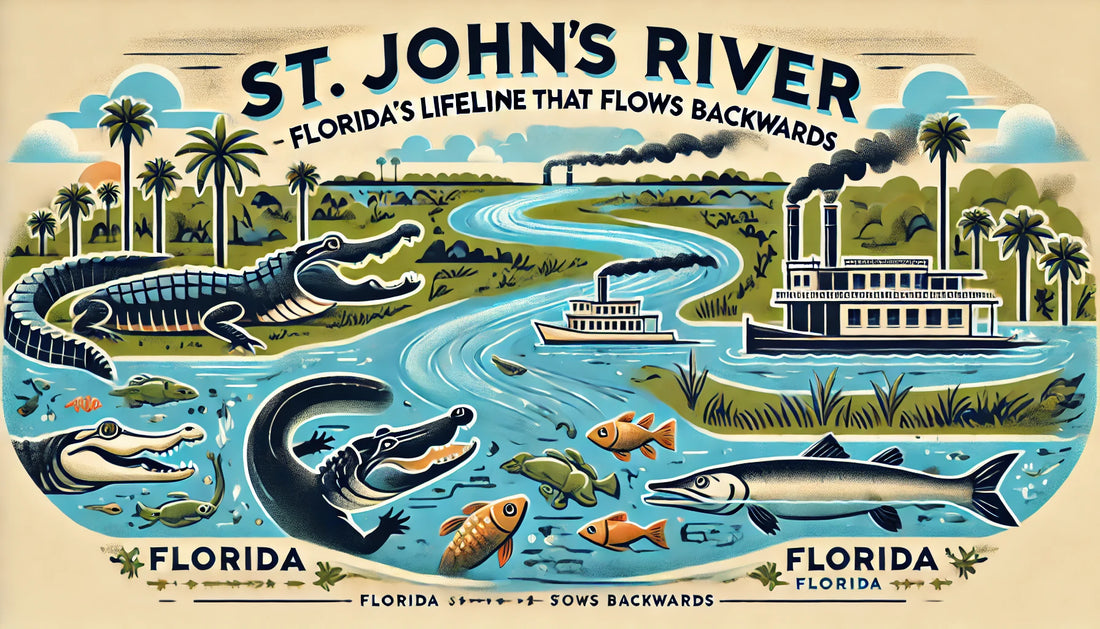
The St. Johns River: Florida's Lifeline That Flows Backwards
Share
Here in Florida, we like our natural features weird. We have lakes full of alligators, a swamp that's a National Park, and, of course, the St. Johns River—a river so bizarre it flows backwards. That’s right, folks. This 310-mile aquatic oddity is too cool to go with the flow. Instead of behaving like a normal river and heading downhill like your career after karaoke night, the St. Johns flows northward, snubbing its watery nose at gravity.
This quirk of geography has left scientists scratching their heads, locals scratching their mosquito bites, and tourists scratching their heads and their mosquito bites.
The Mystery of the Northbound Flow
The St. Johns River starts in Indian River County, where it oozes out of a marshy nothingness that looks like the setting for an alligator-themed horror movie. From there, instead of flowing south like a respectable Florida river, it heads north, ending up in Jacksonville before dumping itself into the Atlantic Ocean, as if it got lost on its way to Miami.
Why does it flow backwards? It’s because Florida is really flat. Seriously, if Florida were any flatter, it’d be a pancake. The St. Johns drops only 30 feet over its entire length—an average of about one inch per mile. That’s less slope than your driveway. So, the river takes the path of least resistance, which just happens to be uphill. (No, I don’t get it either, but science says it’s true.)
Learn more about the St. Johns River’s unique flow.
Ecological Significance: AKA, "Where Alligators Hang Out"

The St. Johns River is basically a 310-mile all-you-can-eat buffet for wildlife. It’s home to manatees, fish, wading birds, and, of course, alligators, which are to Florida what raccoons are to everywhere else: always lurking, always judging.
The river also provides drinking water for millions of Floridians, which explains why some of us drink beer instead. (Just kidding! The water is fine. Probably.) Plus, it’s a crucial part of Florida’s ecosystem, filtering water through its marshes and wetlands like nature’s Brita pitcher.
Check out the St. Johns River Water Management District for more ecological insights.
Cultural and Historical Quirkiness
Humans have been living along the St. Johns for at least 6,000 years, back when Florida Man was just Florida Dude. The Timucuan people fished its waters, Spanish explorers sailed it in search of gold (spoiler alert: they didn’t find any), and later, steamboats puffed their way along its length, ferrying people and goods while trying not to get eaten by the local wildlife.
Today, the river is a recreational hotspot, perfect for boating, fishing, and posting pictures on Instagram with captions like “Livin’ the river life” and “Look! No gators in this one!” Jacksonville even hosts an annual Blessing of the Fleet, where people pray their boats don’t break down in the middle of the river because nobody wants to become alligator food.
Learn about the St. Johns River’s rich history.
The St. Johns: A River Like No Other
The St. Johns River is more than just a backwards-flowing anomaly; it’s a lifeline for Florida, a haven for wildlife, and a playground for people who really like water (and maybe don’t mind the occasional alligator). Whether you’re kayaking its springs, cruising in a pontoon boat, or just standing on its banks wondering how it manages to defy physics, the St. Johns River reminds us of Florida’s unique charm: We’re a little weird, and we like it that way.
So next time you’re in Florida, take a moment to visit the St. Johns River. And remember: If the water looks like it’s going the wrong way, it’s not you—it’s Florida.
Plan your visit to the St. Johns River.
That’s the story of the St. Johns River: the only river in America where you can fish upstream and downstream without moving your boat. Now go out there and enjoy it—but don’t forget the bug spray.
